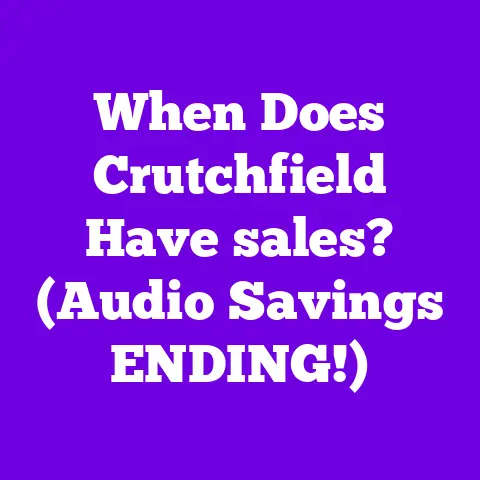When Do Best Time Buy Apple Products Go On Sale? (Deals End Soon!)
Now, I know what you’re thinking: “Apple stuff is expensive!” And you’re not wrong. But here’s the thing: Apple products hold their value like almost nothing else on the market.
That’s why understanding when to buy is so crucial. You’re not just saving money upfront; you’re also maximizing your potential return when you eventually decide to upgrade.
Think of it as an investment, not just a purchase. So, when is the best time to snag that new iPhone, iPad, or MacBook? Let’s dive in!
Section 1: Understanding Apple’s Pricing Strategy
Apple’s pricing is a fascinating beast. It’s not random; it’s a carefully calculated strategy that factors in several things.
First, there’s the “Apple Tax,” which is basically the premium you pay for the brand name, design, and ecosystem.
Then you have to consider the cost of components, manufacturing, and distribution. But the biggest factors influencing when we see sales are product launches, seasonal promotions, and overall market demand.
Apple rarely discounts its products directly, especially the newest models. They prefer to maintain that premium image.
This creates a stable resale market. People are willing to pay more for used Apple products because they know they’re getting a quality device that will last.
However, this also means finding deals requires a bit of detective work, which we’ll get into later.
Section 2: Seasonal Sales and Promotional Events
Okay, let’s get to the good stuff: when can you actually find Apple products on sale? Here’s a breakdown of the major seasonal events:
Black Friday and Cyber Monday
These are probably the most well-known sales events of the year, and they’re a great opportunity to find deals on Apple products.
While Apple itself might not offer huge discounts, authorized retailers like Best Buy, Walmart, and Amazon often do.
I’ve personally seen discounts of up to 20% on older iPhone models, iPads, and even MacBooks during Black Friday.
Timeline: Black Friday is always the Friday after Thanksgiving (late November), and Cyber Monday follows immediately after.
Deals usually start appearing a week or two beforehand, so keep an eye out!
Back-to-School Promotions
If you’re a student, teacher, or know someone who is, this is a fantastic time to buy.
Apple typically offers educational discounts on Macs and iPads, and sometimes throws in free AirPods or other accessories.
These deals are usually available through the Apple Education Store and authorized retailers.
Timeline: Back-to-school promotions usually run from July to September, coinciding with the start of the academic year.
Holiday Sales
The period between Thanksgiving and Christmas is another prime time for deals. Retailers are competing fiercely for your holiday spending, so they’re more likely to offer discounts on Apple products to lure you in.
Timeline: Holiday sales typically start in late November and run through December 25th.
Spring Sales and Product Refresh Cycles
While not as consistent as the other events, some retailers offer spring sales in March or April. This often coincides with Apple’s product refresh cycles.
Timeline: March to April, but it’s less predictable than the other events.
Section 3: Understanding Product Cycles
Apple operates on a pretty predictable product cycle. Knowing this cycle is key to timing your purchases.
Generally, iPhones are released in September, iPads have a few different release windows (spring, fall), and MacBooks are updated throughout the year.
The closer you get to a new product announcement, the more likely you are to see discounts on the current model.
Why? Because retailers want to clear out inventory to make room for the new stuff.
For instance, remember when the iPhone 14 was rumored? Leading up to the launch, I saw some great deals on the iPhone 13, especially on trade-in offers.
This brings me to another point: new product announcements can significantly impact the prices of previous models.
Once the new iPhone is out, retailers will often slash prices on the older models to make them more attractive to budget-conscious buyers.
Section 4: Monitoring Deals and Discounts
Okay, so you know when to look for deals, but where do you find them? Here are some of my go-to resources:
Official Apple Store Promotions
While Apple rarely offers direct discounts, they sometimes have promotions like free gift cards with certain purchases.
Keep an eye on their website and app for these offers.
Authorized Retailers (Best Buy, Walmart, etc.)
These are your best bet for finding actual discounts. Best Buy and Walmart, in particular, are known for their aggressive pricing on Apple products.
Check their websites and weekly ads regularly.
Online Platforms (Amazon, eBay, etc.)
Amazon is a great place to find deals, especially during Prime Day and other major sales events.
eBay can be a bit riskier, but you can sometimes find good deals on used or refurbished Apple products.
Just be sure to buy from reputable sellers with good feedback.
Newsletters and Deal Aggregation Websites
Sign up for newsletters from retailers like Best Buy and Amazon to get notified of sales.
Also, check out deal aggregation websites like Slickdeals and DealNews. These sites scour the web for the best deals and post them in one place.
Section 5: Timing Your Purchase for Maximum Value
Alright, let’s put it all together. Here’s my strategy for timing your Apple purchases to maximize resale value:
Historical Data on When the Best Discounts Occur
Based on my experience, Black Friday and back-to-school promotions tend to offer the biggest discounts.
However, you can often find decent deals throughout the year if you’re patient and keep an eye out.
How to Time Purchases Based on New Product Releases
This is key. If you’re not in a rush, wait until a new product is announced before buying the previous model.
You’ll almost certainly see a price drop.
The Importance of Condition and Packaging in Resale
This is crucial for maximizing resale value. Keep your Apple products in pristine condition.
Use a screen protector and case, and avoid dropping or scratching them. Also, save the original packaging and accessories.
Having the original box can significantly increase the resale value.
Here’s a breakdown by category:iPhones: Timing for New Releases and Trade-In Offers
As I mentioned earlier, the best time to buy an iPhone is usually right before or after a new model is released.
Also, take advantage of trade-in offers. Apple and other retailers often offer generous trade-in values for older iPhones, which can significantly reduce the cost of a new one.
iPads: Differences in Pricing Between Models and When to Buy
iPad pricing can vary widely depending on the model. The entry-level iPad is usually the most affordable, while the iPad Pro is the most expensive.
Look for deals on older iPad models when new ones are announced. Also, back-to-school promotions are a great time to buy an iPad for students.
MacBooks: Seasonal vs. Year-Round Sales
MacBook deals are a bit less predictable than iPhone or iPad deals. However, you can often find discounts during Black Friday, back-to-school, and other major sales events.
Also, keep an eye out for refurbished MacBooks on Apple’s website. These are often significantly cheaper than new models and come with a warranty.
Accessories: When to Find the Best Deals
Apple accessories like AirPods, Apple Watches, and charging cables are often discounted during sales events.
Amazon is a great place to find deals on accessories, especially during Prime Day.
Section 7: Future Trends and Predictions for 2025
Okay, let’s put on our futurist hats for a moment. What can we expect to see in terms of Apple sales and resale values in 2025?
I think we’ll continue to see the trend of retailers offering more aggressive discounts on older models when new products are released.
Trade-in programs will likely become even more popular, as Apple and other retailers try to encourage customers to upgrade.
I also think we’ll see more emphasis on sustainability and refurbished products. As consumers become more environmentally conscious, they’ll be more likely to consider buying used or refurbished Apple products.
Of course, economic factors and consumer behavior shifts could also play a role. If the economy weakens, we might see more discounts and promotions as retailers try to stimulate demand.
Remember, the key is to be patient, do your research, and take advantage of sales events and trade-in offers.
By following these tips, you can save money upfront and maximize your potential return when you eventually decide to upgrade.
Call to Action
Now, go forth and conquer the world of Apple deals! Keep an eye on those sales, stay informed about upcoming product announcements, and make smart purchasing decisions that will benefit your wallet both now and in the future. Happy shopping!






